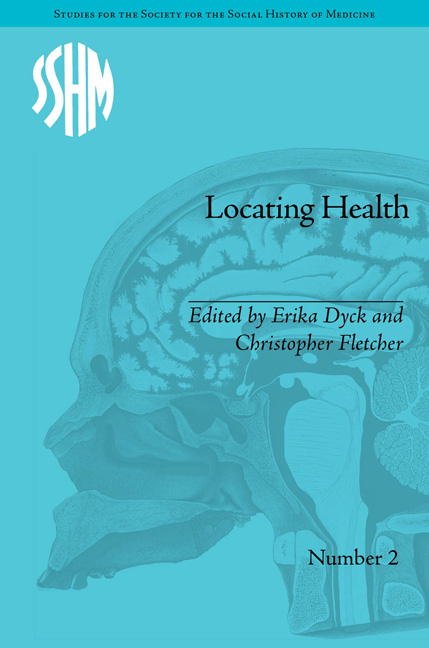Book contents
- Frontmatter
- CONTENTS
- List of Tables
- List of Contributors
- Acknowledgements and Preface
- Introduction: Healthscapes: Health and Place among and between Disciplines
- 1 Placing Maternal Health in India
- 2 Putting Medicine in its Place: The Importance of Historical Geography to the History of Health Care
- 3 Finding Place in The Big-Little World of Doc Pritham: Telling Medical Tales about Northwoods Maine, 1920s–70s
- 4 Putting Hyperactivity in its Place: Cold War Politics, the Brain Race and the Origins of Hyperactivity in the United States, 1957–68
- 5 Why Canada Has a Universal Medical Insurance Programme and the United States Does Not: Accounting for Historical Differences in American and Canadian Social Policies
- 6 Alberta Advantage: A Canadian Proving Ground for American Medical Research on Mustard Gas and Polio in the 1940s and 50s
- 7 Placing Illness in its Cultural Territory in Veracruz, Nicaragua
- 8 Chronic Disease in the Yukon River Basin, 1890–1960
- 9 An Ideal Home for the Consumptive: Place, Race and Tuberculosis in the Canadian West
- 10 Serbian Landscapes of Dreamtime and Healing: Clear Streams, Stones of Prophesy, St Sava's Ribs, and the Wooden City of Oz
- Notes
- Index
8 - Chronic Disease in the Yukon River Basin, 1890–1960
- Frontmatter
- CONTENTS
- List of Tables
- List of Contributors
- Acknowledgements and Preface
- Introduction: Healthscapes: Health and Place among and between Disciplines
- 1 Placing Maternal Health in India
- 2 Putting Medicine in its Place: The Importance of Historical Geography to the History of Health Care
- 3 Finding Place in The Big-Little World of Doc Pritham: Telling Medical Tales about Northwoods Maine, 1920s–70s
- 4 Putting Hyperactivity in its Place: Cold War Politics, the Brain Race and the Origins of Hyperactivity in the United States, 1957–68
- 5 Why Canada Has a Universal Medical Insurance Programme and the United States Does Not: Accounting for Historical Differences in American and Canadian Social Policies
- 6 Alberta Advantage: A Canadian Proving Ground for American Medical Research on Mustard Gas and Polio in the 1940s and 50s
- 7 Placing Illness in its Cultural Territory in Veracruz, Nicaragua
- 8 Chronic Disease in the Yukon River Basin, 1890–1960
- 9 An Ideal Home for the Consumptive: Place, Race and Tuberculosis in the Canadian West
- 10 Serbian Landscapes of Dreamtime and Healing: Clear Streams, Stones of Prophesy, St Sava's Ribs, and the Wooden City of Oz
- Notes
- Index
Summary
Introduction
In the nineteenth and twentieth centuries, chronic illnesses often chased newcomers out of northern environments. Amongst Anglican missionaries in the Yukon alone there are numerous instances of physical retreat. Reverend W. H. Fry, stationed with his wife on Herschel Island in 1916, left the region abruptly in 1919 as a result of his health. Upon his departure he wrote to his superior, Bishop Stringer, that ‘The climate I believe is hard on me and perhaps the absence of fresh foods is not agreeable to my inner man’. Although his health was partly restored upon his return to Ontario – he reported gaining 20 pounds within a few short months – Fry nevertheless died within two years. Rev. Fry's experience on Herschel Island was by no means unique. Robert McDonald arrived in Fort Yukon in 1862. He married Julia Kutug, a Gwich'in woman and raised his family in Fort Yukon and later Fort McPherson. But he eventually left the Yukon due to declining health in 1905 and returned to Winnipeg where he lived out his final years. Bishop Geddes similarly left the Yukon as a result of rheumatism, while Archdeacon Whittaker departed from Whitehorse in 1921 due to his wife's ill-health. Chronic diseases afflicted Native peoples as well but for them northern environments were home, not harsh places to flee for health reasons. Julia McDonald, for instance, stayed in the Yukon after Robert's death, dying in Dawson in 1938.
- Type
- Chapter
- Information
- Locating HealthHistorical and Anthropological Investigations of Place and Health, pp. 129 - 150Publisher: Pickering & ChattoFirst published in: 2014



